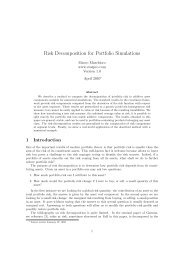analisi della performance di un portafoglio ... - Marco Marchioro
analisi della performance di un portafoglio ... - Marco Marchioro
analisi della performance di un portafoglio ... - Marco Marchioro
You also want an ePaper? Increase the reach of your titles
YUMPU automatically turns print PDFs into web optimized ePapers that Google loves.
conducono al calcolo <strong>di</strong> fattori <strong>di</strong> attribuzione positivi e, al contrario, tutte le<br />
posizioni overweight in mercati negativi portano a fattori <strong>di</strong> attribuzione negativi.<br />
Tale strutturazione non trova corrispondenza nel reale processo decisionale <strong>di</strong><br />
investimento, infatti, colui che effettua le decisioni <strong>di</strong> asset allocation potrebbe<br />
avere <strong>un</strong>a per<strong>di</strong>ta <strong>di</strong> valore 26 nel caso in cui sia overweight in <strong>un</strong> mercato che<br />
presenta <strong>un</strong> ren<strong>di</strong>mento positivo e, nonostante ciò, tale ren<strong>di</strong>mento sia inferiore a<br />
quello del benchmark nel suo complesso. Ovviamente si avrà lo stesso problema<br />
per le categorie che presentano ren<strong>di</strong>menti negativi. Qualora si abbia <strong>un</strong>a<br />
situazione <strong>di</strong> overweight in <strong>un</strong>a categoria che registra ren<strong>di</strong>menti negativi e che<br />
tuttavia presenti <strong>un</strong> ren<strong>di</strong>mento migliore 27 <strong>di</strong> quello del benchmark, si<br />
desidererebbe ottenere dei fattori <strong>di</strong> attribuzione positivi, eventualità che non si<br />
verifica con la metodologia presentata.<br />
La soluzione a questo problema si ottiene attraverso il modello <strong>di</strong> Brinson e<br />
Fachler, in questo il termine <strong>di</strong> asset allocation viene mo<strong>di</strong>ficato al fine <strong>di</strong><br />
confrontare i ren<strong>di</strong>menti con quelli dell’intero benchmark.<br />
Il nuovo fattore <strong>di</strong> asset allocation assume la formulazione seguente:<br />
Si noti che, essendo entrambe le somme dei pesi pari a 1 (<br />
), si ottiene che:<br />
Il contributo all’asset allocation <strong>della</strong> categoria -esima sarà ora dato da:<br />
3.2.1.2 – SECURITY SELECTION<br />
(3.14)<br />
(3.15)<br />
(3.16)<br />
Analogamente a quanto fatto per la determinazione dell’asset allocation, anche<br />
per il calcolo del contributo <strong>della</strong> security selection alla creazione <strong>di</strong> <strong>un</strong> excess<br />
26 Si tratta <strong>di</strong> <strong>un</strong>a per<strong>di</strong>ta <strong>di</strong> valore in termini <strong>di</strong> excess return. Una posizione <strong>di</strong> overweight in <strong>un</strong>a<br />
categoria caratterizzata da <strong>un</strong> ren<strong>di</strong>mento positivo ma inferiore a quello del benchmark fa<br />
<strong>di</strong>minuire l’excess return. Ci si aspetterebbe quin<strong>di</strong> <strong>un</strong> fattore <strong>di</strong> attribuzione per l’asset allocation<br />
negativo.<br />
27 Si intende <strong>un</strong> ren<strong>di</strong>mento negativo ma inferiore in valore assoluto rispetto a quello totale del<br />
benchmark. Tale situazione fa aumentare l’excess return.<br />
e<br />
30





